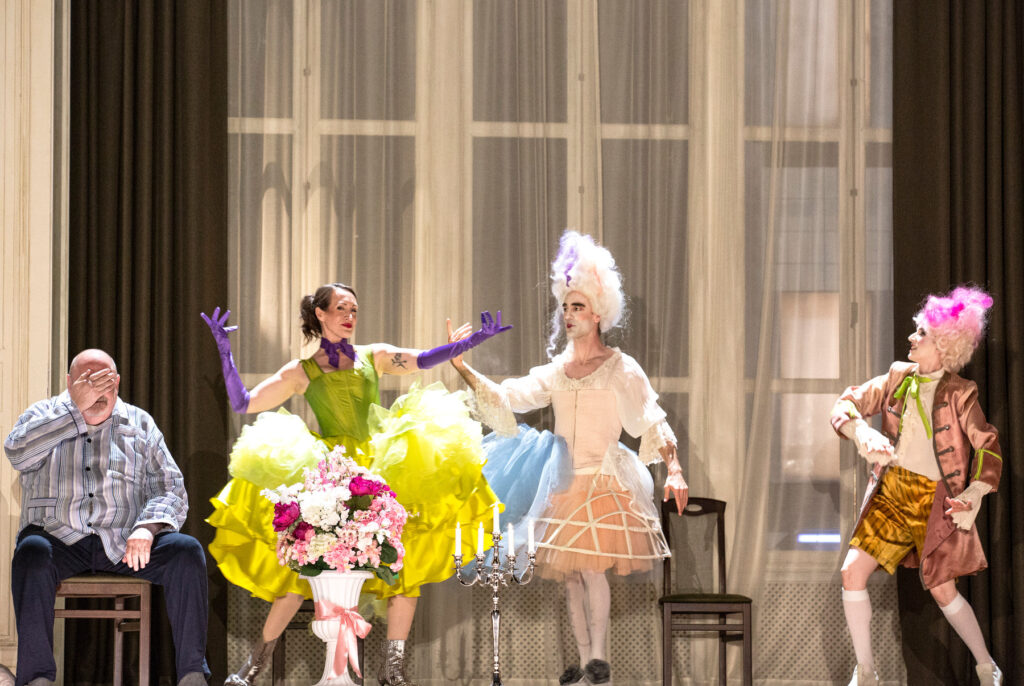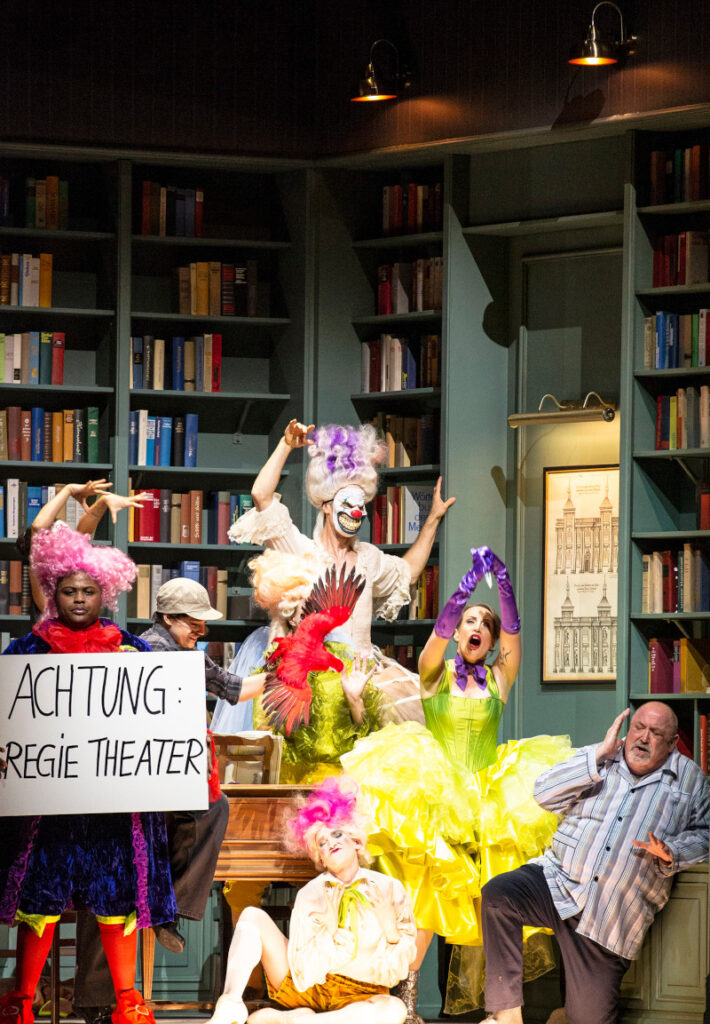Die schweigsame Frau (1935) was Strauss’s only collaboration with Stefan Zweig – a writer as prominent and satisfactory for the composer to work with as Hugo von Hofmannsthal had been until his sudden death. In adapting a play by Ben Jonson, they created what is essentially a modern opera buffa, founded upon the particular conventions of that genre rather than the more general characteristics of comedy such as Der Rosenkavalier. Were it not for Verdi’s Falstaff it might be better regarded today than it is in fact.
Jan Philipp Gloger adapts the scenario – set originally in Jacobean London – to the present day, though Sir Morosus is still a retired admiral, a former public servant of the establishment who remains entirely recognisable today as a Colonel Blimp figure, probably writing letters to the Daily Telegraph. Despite his initial irascibility, as he seeks a wife who will be obedient and silent, he is humanised here. Rather than made a figure of fun for his eccentric obsession with silence, his crotchety behaviour is a defensive front for his helpless loneliness, as we see at the end of the first act – a point explicitly made with the quotations from recent articles in German papers about the problem of increasing numbers of solitary older people, which are projected on the curtain before the start of the ensuing acts. The trick played by his nephew, Henry, and his wife, Aminta, is resolved in Morosus’s finding peace not by returning to isolation but by accepting the calm contentment of their company and that of their opera troupe.

The trick played on Morosus gave Strauss the chance to create a series of play-within-play scenarios by the actors and singers of the troupe, in a way that is more integrated in the narrative of the comedy than the tacking on of a staged drama at the end of Ariadne auf Naxos. Since Morosus warmly accepts the troupe’s company in this re-interpretation of the opera, the social and cultural value of music and the theatre here is also emphasised all the more. (In his score Strauss adapted Elizabethan music from the Fitzwilliam Virginal Book and Monteverdi is also quoted in a florid elaboration.) Gloger’s staging manifests the lively, hyperactive spirit of opera buffa with the cast’s hectic choreography, squeezed into the handful of rooms of Morosus’s flat, framed and structured within a box on stage to underline the tautness of the action. The choreography lifts some of the drama’s longueurs to ensure there’s no relaxation of tension.

The singers also maintain that level of witty volatility as suits the action in a score that has much less of the sustained symphonic sweep that is typical of Strauss’s other operas but which really requires a set of good character actors. Peter Rose isn’t a blustering Morosus, but despatches the part with conversational vigour, seeing that the vocal writing is generally concise. Samuel Hasselhorn is a highly effective and voluble Schneidebart – here Morosus’s chiropractor, rather than a barber – who cooks up the scheme which Henry and his troupe are to carry out, as much in spoken dialogue as vocal. Brenda Rae demonstrates winning versatility as Aminta, charmingly voiced as herself, but contriving to be alluringly demure when presented to Morosus as ‘Timidia’, a possible silent wife, and amusingly explosive after their pretend marriage. Siyabonga Maqungo achieves moments of lyricism as Henry, but other times he sounds more vocally constricted. If Iris Vermillion is an upright Widow Zimmerlein, Morosus’s housekeeper, then there are some delightfully unabashed performances from the other soloists who take the part of the troupe’s singers, such as the two other marriage prospects put forward to Morosis in Rebecka Wallroth’s Cockney-voiced simple country girl impersonation, and Serafina Starke’s priggishly studious noblewoman.

Coming at the end of his first season as music director of the Staatsoper, Christian Thielemann conducts the Staatskapelle in a generally nuanced account. They start with a convivial way in the Overture and keep up an easy-going restraint with the music, though the tempo remains alert and in pace with the comic action on stage. More urgency or passion comes at telling moments, such as the Elektra-like dissonant, frenetic energy unleashed when Aminta’s ‘Timida’ starts to make life hell for Morosus, or the veiled lushness of the duet between Henry and Aminta in act two, making an ironic parallel to Tristan und Isolde. Without compromising the work’s vivacious and farcical elements, Gloger succeeds in also imparting a serious message.
Curtis Rogers
Die schweigsame Frau
Composer: Richard Strauss
Libretto: Stefan Zweig, after Ben Jonson’s Epicœne
Cast and production staff:
Sir Morosus – Peter Rose; Widow Zimmerlein – Iris Vermillion; Barber Schneidebart – Samuel Hasselhorn; Henry Morosus – Siyabonga Maqungo; Aminta – Brenda Rae; Isotta – Serafina Starke; Carlotta – Rebecka Wallroth; Morbio – Dionysios Avgerinos; Vanuzzi – Manuel Winckhler; Farfallo – Friedrich Hamel
Director – Jan Philipp Gloger; Designer – Ben Baur; Costumes – Justina Klimczyk; Lighting Designer – Tobias Krauß; Video – Leonard Wölfl; Choreographer – Florian Hurler; Dramaturg – Detlef Giese; Conductor – Christian Thielemann; Staatsopenchor and Staatskapelle Berlin
Staatsoper Unter den Linden, Berlin, Germany, Thursday 24 July 2025
Top image: Rebecka Wallroth (Carlotta), Peter Rose (Sir Morosus), Manuel Winckhler (Vanuzzi), Serafina Starke (Isotta), Brenda Rae (Aminta), Samuel Hasselhorn (Barbier Schneidebart), Ensemble
All photos by Bernd Uhlig